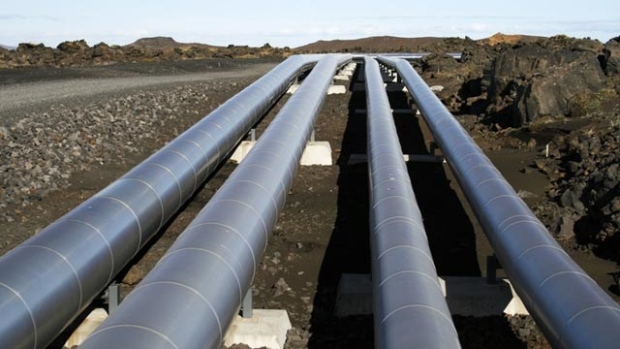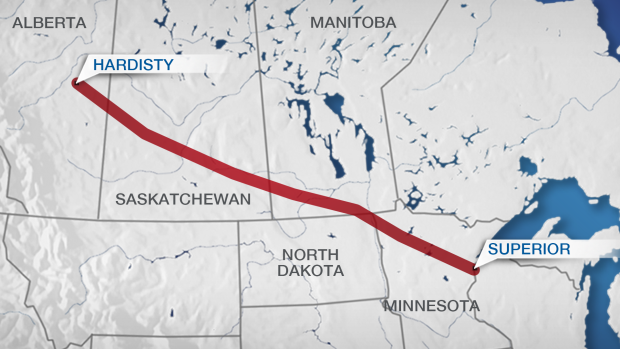Nov 25, 2016
Ottawa expected to make major decisions on Enbridge pipelines
, The Canadian Press

CALGARY -- The federal government's lengthy balancing act between the energy industry and the environment will soon be tested as it rules on the fate of two major oil sands pipeline projects.
The government has committed to decide by Friday on two projects proposed by Enbridge: the Line 3 pipeline replacement and Northern Gateway pipeline.
Reuters reported Thursday that the government would announce its decisions on Tuesday, citing sources it said were familiar with the matter. The government declined to comment on the report, saying only that the decision will be announced after the decision is made.
Line 3 would replace a decades-old conduit that runs from Hardisty, Alta., to Superior, Wisc., and double its capacity. Enbridge has described it is an essential safety and maintenance project.
In the politically charged debate over pipelines, Line 3 has been largely overshadowed by other projects such as the Trans Mountain expansion and Energy East.
The National Energy Board recommended Line 3's approval in April, subject to 89 conditions. There are some expectations, at least within industry, that Ottawa will sanction it. Such a decision would be the first oilsands pipeline expansion on Prime Minister Justin Trudeau's watch.
Trevor McLeod, director of the Centre for Natural Resources Policy at the Canada West Foundation, said the government has been trying to achieve the delicate task of building acceptance of pipelines with stringent environmental regulations, such as a carbon tax.
"He's decided on what I call the thread the needle strategy -- he's decided we don't have to choose between economic development and energy development and the environment," said McLeod.
Approval of the $7.5-billion Line 3 project would allow for exports to increase from 390,000 to 760,000 barrels a day since Enbridge has been running the 1960s-era pipeline at reduced capacity. It also has the potential to be expanded to 915,000 barrels a day with further permitting and pump stations.
While the energy industry would welcome Line 3, environmentalists have decried the project for the increased emissions it would allow.

The government also has to decide on whether to proceed with further First Nations consultations on Northern Gateway after a Federal Court of Appeal ruled earlier this year that the previous Conservative government had failed in its duty to consult. Trudeau has signalled in the past that he's against the project.
Mike Hudema, climate and energy campaigner at Greenpeace Canada, said if Line 3 were approved but Northern Gateway rejected, it would set back Canada's efforts to combat climate change.
"It will be a great day of celebrations for communities in northern B.C., but a bad day for climate action in Canada overall," said Hudema. "You're opening up new resources and emissions."
Line 3 has seen significant opposition in Minnesota, where those opposed have launched legal battles and challenging, and Hudema said that opposition will likely grow if it's approved in Canada.
Grand Chief Derek Nepinak of the Assembly of Manitoba Chiefs agreed.
"The climate-killing Enbridge Line 3 tarsands pipeline will never see the light of day," Nepinak said in a statement.
"As a result of the co-ordinated opposition by Indigenous People in both Canada and the U.S., exerting their own sovereign jurisdiction and supported by their non-Indigenous allies, Line 3 will end up on the same scrap heap as Enbridge's
Northern Gateway tarsands pipeline. Line 3 needs to be repaired and then shut down and cleaned up."
The government has committed to factoring in the emissions findings and feedback from enhanced consultations and the NEB's recommendations, but a spokesman for Natural Resources Minister Jim Carr emphasized they will also factor in economic benefits.
"We have been clear that environmental protection and economic development must go hand-in-hand," said Alexandre Deslongchamps in an email.
By the Numbers: Line 3 and Northern Gateway
Line 3 replacement
Estimated cost: $7.5 billion
Distance: 1,660 km
Planned in-service date: 2019
Estimated capacity: 760,000 barrels per day
Northern Gateway
Estimated cost: $7.9 billion
Distance: 1,177 km
Conditions applied by National Energy Board: 209
Approved by Harper government in 2014
Overturned by Federal Court of Appeal in 2016
Project launched in 2004
What you need to know about Enbridge's Line 3 pipeline project
The Line 3 crude oil pipeline replacement project proposed by Calgary-based Enbridge Inc. has attracted little attention despite its potential to increase Canadian exports to the United States. Here are some facts about the plan:
-- The $7.5-billion, 1,660-kilometre pipeline replacement project would be the most expensive in Enbridge history.
-- The line is almost half a century old and its regulated maximum throughput has been reduced through pressure restrictions to about 390,000 barrels of oil per day.
-- The replacement of the aging 34-inch diameter pipe with new 36-inch pipe will restore the original regulated capacity of 760,000 barrels per day, nearly doubling oil shipping potential.
-- In April, the National Energy Board recommended approval of the Canadian part of the project with 89 conditions.
-- Line 3 already has a U.S. presidential permit, unlike the higher-profile Keystone XL pipeline project which was rejected by the Obama administration a year ago. Line 3 still requires state regulator approvals.
-- On the Canadian side of the border, Enbridge intends to spend $4.9 billion to replace Line 3 between Hardisty, Alta., and the Canada-U.S. border at Gretna, Man.
-- On the U.S. side, it will spend US$2.6-billion to replace pipe between Neche, N.D., and its terminal in Superior, Wis., from which crude can be transported to refinery markets in Chicago, the U.S. Gulf Coast and the eastern U.S. and Canada.
-- Decommissioning of the existing Line 3 pipe will begin after the replacement pipeline is in service. Product will be removed and the line will be cleaned but the pipe itself is to be left in the ground.



